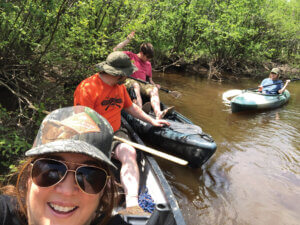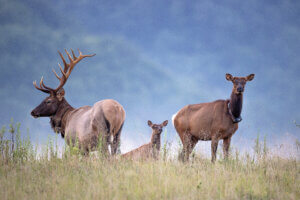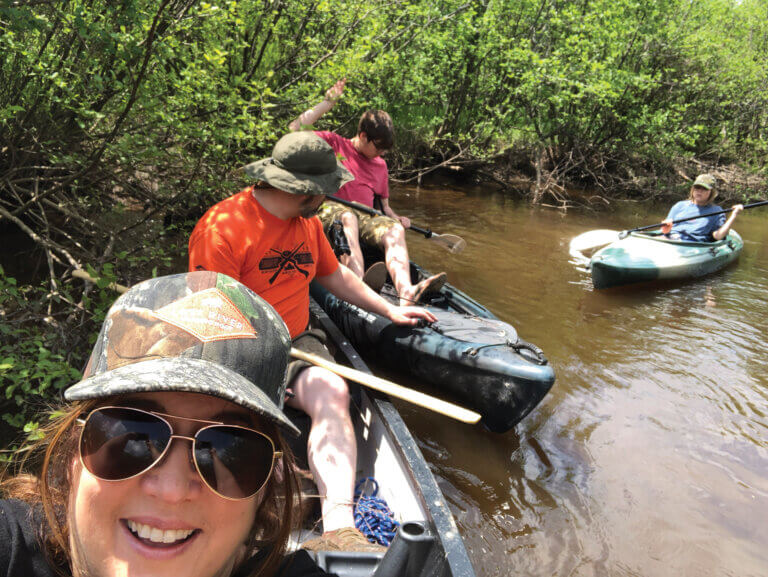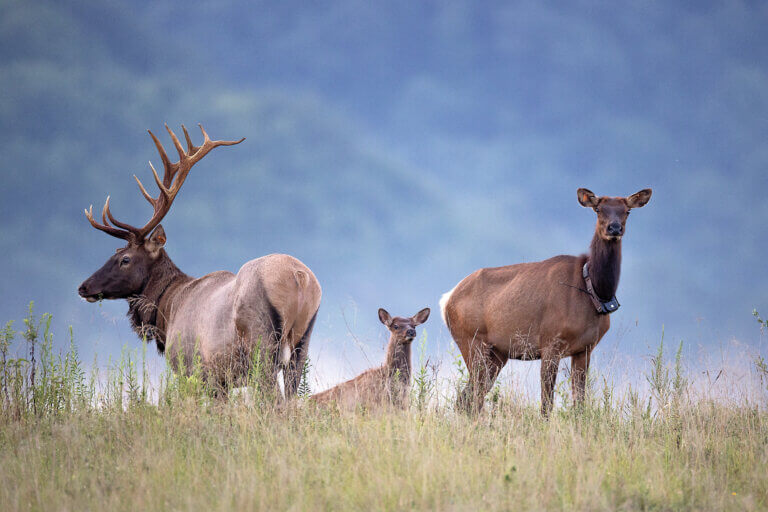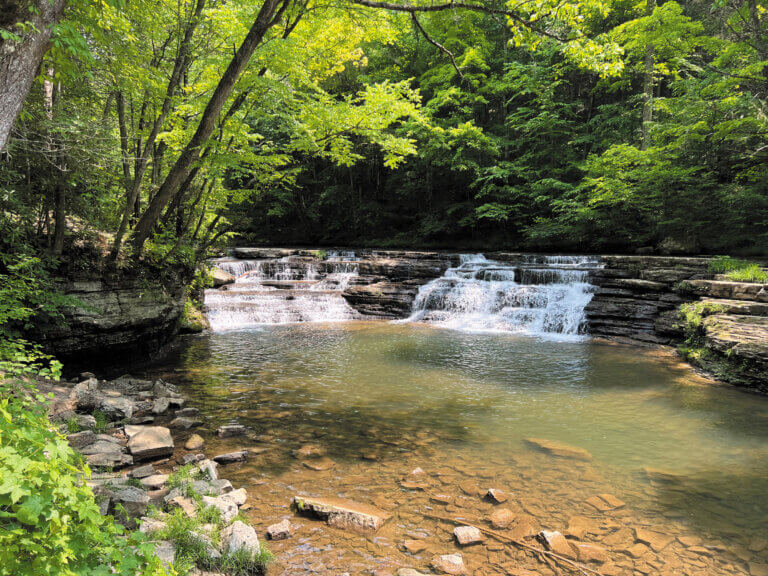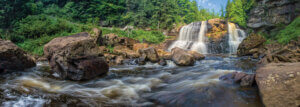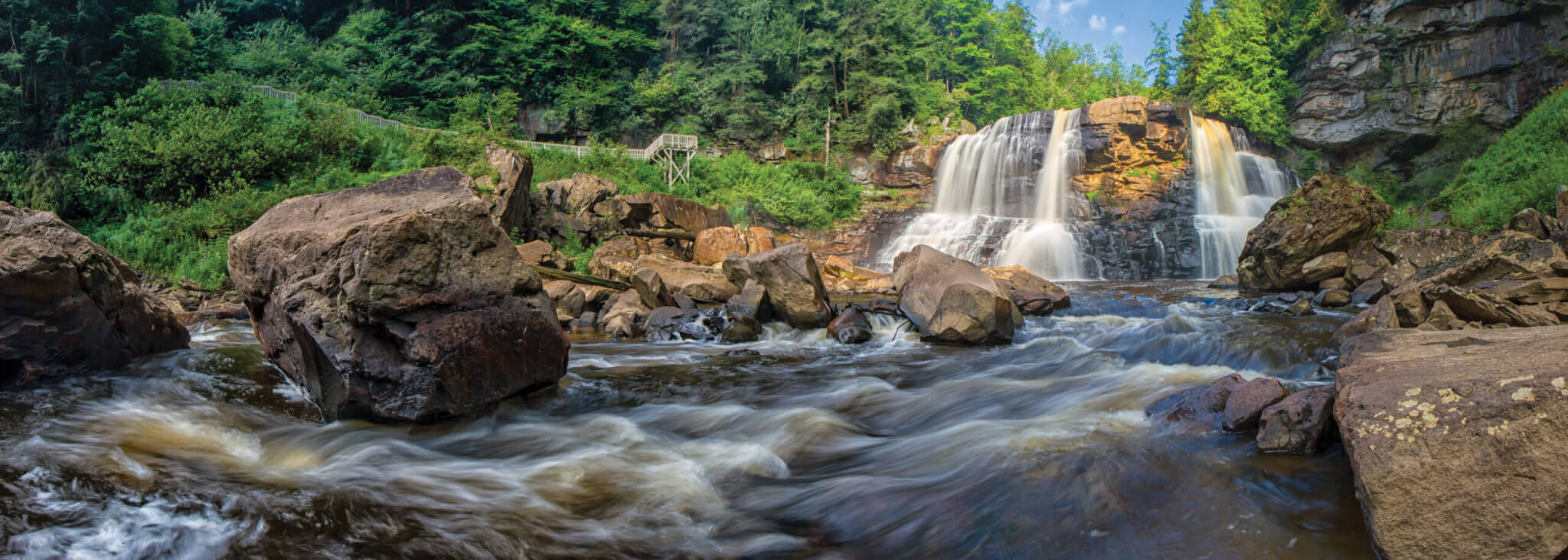
Blackwater Falls has long inspired awe in travelers to the Mountain State, and the state park built around it offers even more opportunities for enjoyment.
This story was originally published in the August 2024 issue of Wonderful West Virginia. To subscribe, visit wonderfulwv.com.
Written by Stan Bumgardner
Photographed by Frank Ceravalo
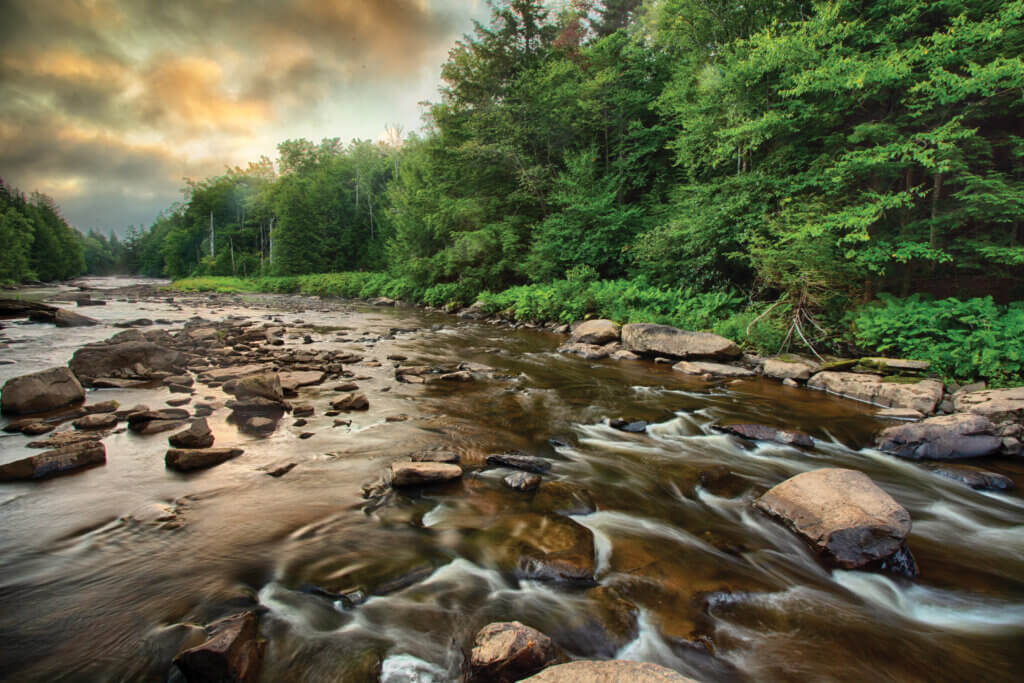
After an arduous trek into the depths of the Blackwater wilderness, author and artist David Hunter Strother – known by the pen name Porte Crayon – wrote in the 1870s of camping with his party near Blackwater Falls, “… surrounded by a tangled thicket of rhododendron, canopied by the loftiest firs, the thunder of the cataract in their ears day and night, and its spray freshening the atmosphere they breathed.”
Two decades earlier, in June 1851, Strother provided us with our earliest-known illustration of the falls. It was for his cousin Philip Edward Pendleton’s book The Blackwater Chronicle, about their trout-fishing expedition to the canyon—an often humorous travelog, of sorts. Of course, prehistoric cultures had already been fishing and hunting, getting water, and being generally astonished, no doubt, by these sites for thousands of years.
The Falls
West Virginia is known for its striking waterfalls, including whitewater rapids, which basically are tiny falls. If you’re like my family, a trip to Blackwater Falls was a childhood ritual. I still have photos of me there in the 1970s. My father’s family took their own vacation to the falls 40 years before.
The waterfall itself is just one facet of a natural marvel. The Blackwater River starts on the western slope of the Allegheny Front at an elevation of 3,250 feet. It meanders slowly for a long while, falling only 200 feet by the time it enters Blackwater Falls State Park. Creeping to almost a halt, it picks up tannins from decayed hemlock and red spruce needles, giving it an amber tint—hence the name “Blackwater.” The slow-moving stream also forms the bogs for which Canaan Valley is known.
After entering the park, the river’s elevation drops more than 2,000 feet—more than one-third of a mile—in 2.2 miles, including the precipitous 57-foot drop known as Blackwater Falls. The river descends another 560 feet until relatively leveling out near the state park lodge. At Hendricks, it joins with Dry Fork to form the Black Fork, which merges with Shavers Fork to form the Cheat River.
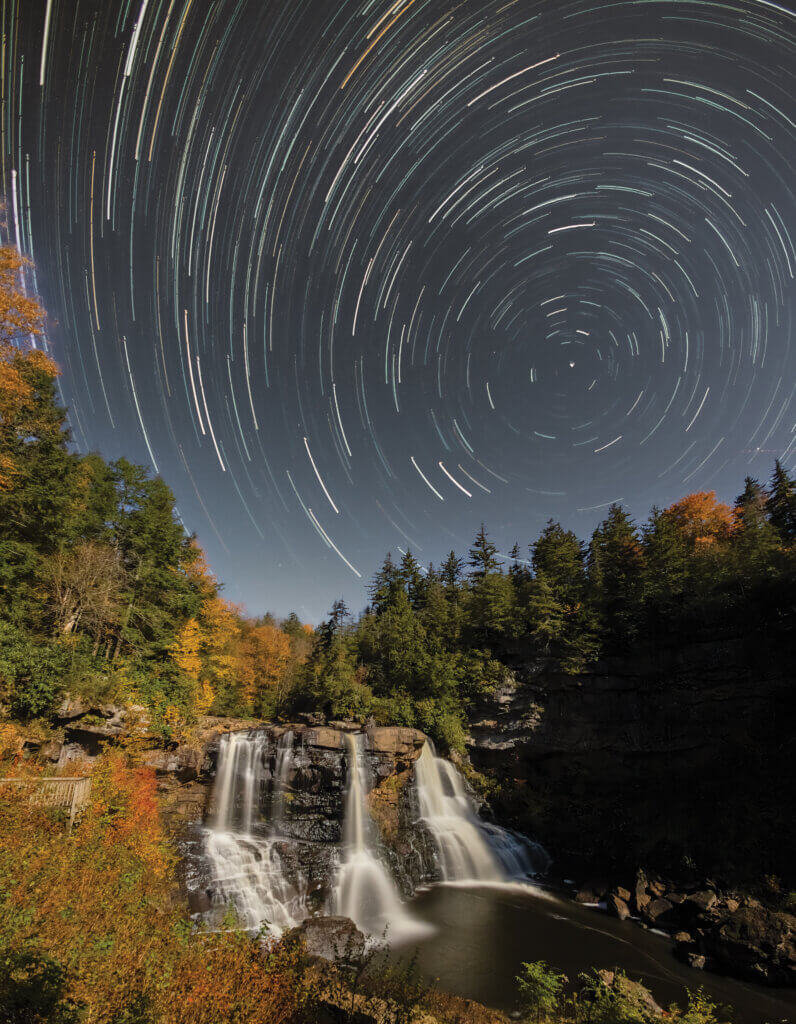
The snail-paced Blackwater River is approximately 100 million years old. That’s relatively young, in geological time—the New River, by comparison, is three times older. Over millions of years, the Blackwater slowly sliced a canyon through sandstone rock, which itself comes from river sediment. So, why hasn’t the ledge of the falls eroded as much as the rest? Some rocks are harder than others. The overhang consists of a more erosion-resistant sandstone known as Connoquenessing.
Despite geology’s sluggish degree of change, dramatic weather events can produce quick variations. Precipitation, especially in large quantities, can alter how the falls flow and look. The deadly 1985 flood, for instance, decreased the falls’ drop from 65 to its current 57 feet.
The Park’s Early Days
While science makes Blackwater Falls seem even more phenomenal, you don’t have to be a geologist to take in the cascade’s grandeur. It’s arguably been a popular destination for time immemorial. A 12-room lodge was built there as early as 1859, but the rugged mountains that helped shape this work of art historically have prevented most people from even getting there. That all changed with the coming of modern roads and affordable automobiles in the 1920s. Vacationers and day visitors could drive so close to the falls that they did not have to worry about the fatigue Strother had experienced. Even with those early roads and cars, though, it still took a lot longer to get there than it does now.
The roads had arrived just in time for my father’s Blackwater vacation in the 1930s, but what he saw was a far cry from what Strother had seen 60 years earlier. In the ensuing years, crosscut saws and steam-powered machines had denuded nearly all of the surrounding woods. The falls still flowed, poisoned by toxins, and the rest looked like a moonscape.
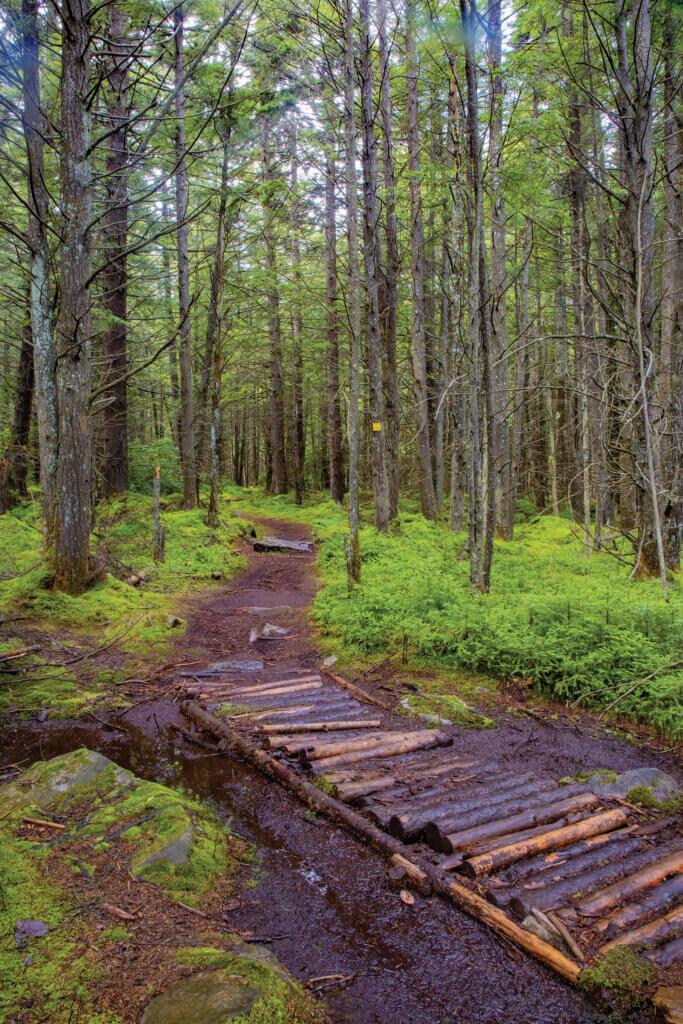
Hit the Trail
Blackwater Falls State Park is criss-crossed by more than 20 miles of hiking trails and 10 miles of cross country skiing trails. Here are a few shorter ones that lead to interesting features.
Allegheny Trail portion, 1.2 miles
A more strenuous trail that is part of the larger Allegheny Trail. Overnight parking is available, but must be registered with the park.
Blackwater Falls Boardwalk Trail, 0.25 miles
A trail just off the Trading Post, involving more than 200 steps to reach the main viewing platform of the falls.
Davis Trail, 0.25 miles
A shared hiking and biking connector that leads from the state park into the Monongahela National Forest, where the trail increases in difficulty.
Gentle Trail, 0.25 miles
An easier, paved walking trail to a viewing platform for those who wish to see Blackwater Falls without climbing the steps of the Boardwalk Trail.
Lindy Point Trail, 0.3 miles
See Blackwater Canyon from overhead by traveling this moderate, shared trail for hikers and cross country skiers.
River Road Trail, 1.6 miles
Winding parallel to the Blackwater River, this hiking and biking trail provides ample opportunities for anglers to cast a line.
Thanks to New Deal programs such as the Civilian Conservation Corps and natural stewards such as the West Virginia State Parks system and the U.S. Forest Service, the forests around Canaan Valley and Blackwater Falls made a comeback. Using environmentally sound practices for planting trees and fighting forest fires, plants and trees thrived. Tucker County’s trees and plants flourish more now than they did when Strother and his pals were casting for trout in the 1850s.
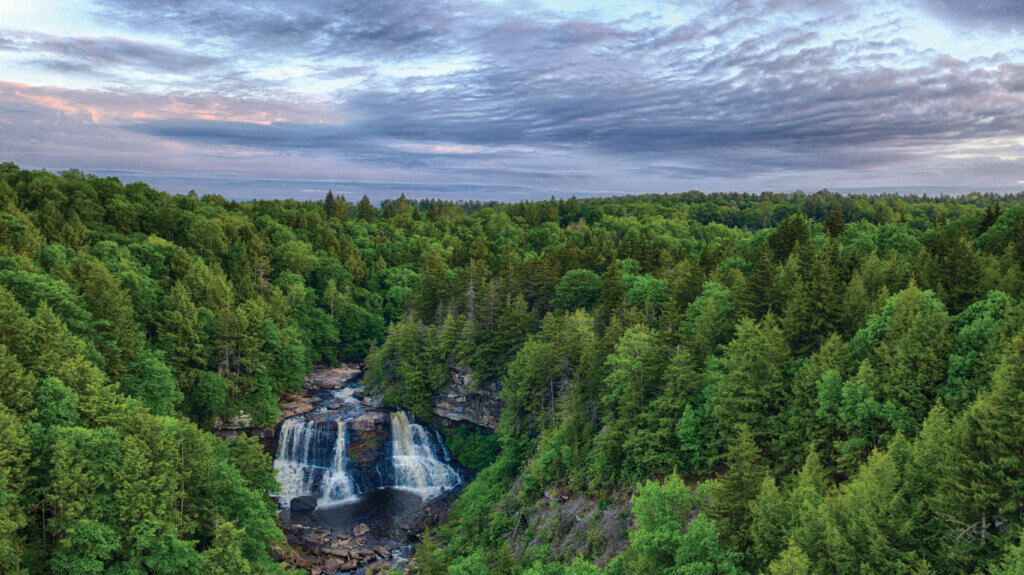
Recognizing the region’s tourism potential, the state Conservation Commission—the West Virginia Division of Natural Resources’ forerunner—obtained a 10-year lease on 446 acres in 1934 from the West Virginia Power and Transmission Company, adding over 1,000 acres more over the years. Blackwater Falls became one of our earliest state parks in 1937. The lodge was added in 1956 and the first campground built in 1961, making it even more of a destination.
Grab a Bite
Dining options abound in and around Blackwater Falls State Park. Located at the park lodge, Smokehouse at Blackwater Falls offers a variety of flavors and dishes that are sure to make your mouth water, from meats fresh from the smoker to classic appetizers and decadent soups. Guests can be served breakfast, lunch, and dinner all week. The Smokehouse will also be hosting a Farm to Table Dinner on September 6, 2024, where guests can enjoy dishes made with fresh, locally grown products.
Just minutes away in the neighboring town of Thomas and Davis are a variety of other local spots where you can find a good meal on your way in or out of the park. After you’ve worked up an appetite with a day on the trails, grab a slice at Sirianni’s Pizza Cafe or enjoy a West Virginia take on Mexican cuisine at Hellbender Burritos. Speaking of tacos, pop over to Picnic in Thomas, a delicious stop on the West Virginia Culinary Trail offering vibrant, flavorful tacos and perfectly paired beverages. Take note of TipTop coffee shop while you’re there—you’ll need to fuel up on your next day of adventure! Davis’ ISH Kitchen offers up eclectic dishes with influences from all around the globe. And for dessert, The Ice Cream Shop nearby will satisfy the biggest sweet tooth.
In the 1970s, Blackwater Falls—and Seneca Rocks—were featured in every tourism commercial and on most West Virginia–themed T-shirts, not to mention those laminated placemats that graced the counters of every fine diner, making them instantly identifiable natural icons of the Mountain State.
Growing and Welcoming
Blackwater Falls State Park has been busy in recent years carrying out renovations and opening new attractions. If you haven’t been in a while, the first thing you’ll notice is the lodge. While it still has that quaint, rustic look of the original, it’s been completely gutted and rebuilt with modernized amenities in the guest rooms, updates to the common areas, a fitness center, a gift shop, and a barbecue-themed restaurant that has a view to rival any eatery in the world. The lodge’s conference center hosts everything from large meetings to family reunions. If you go with family or friends, consider renting one of the park’s 39 cabins or staying at the campground, which includes some sites with hookups.
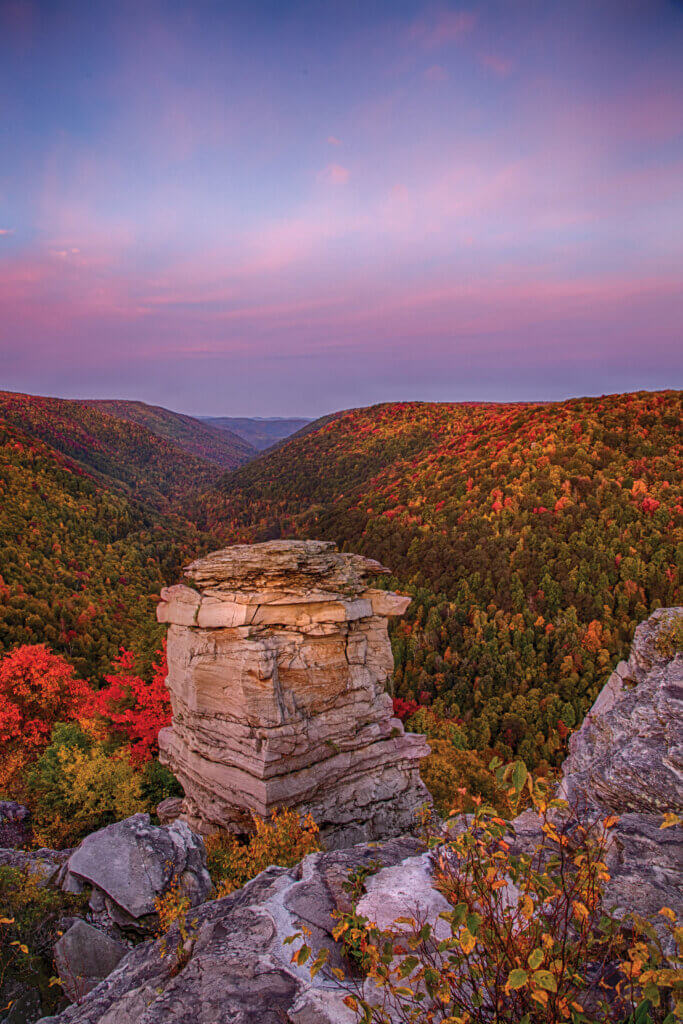
Blackwater Falls is a fun trip for a day, overnight, a weekend, or a whole week. It’s easy to lose track of time, because there’s so much to do. Like most state parks, it features fishing, hiking, and mountain biking. Blackwater’s park naturalist, Pauletta Cousins, hosts regular outdoor activities, like kids’ day camps, nature walks, and educational presentations.
When it comes to adventure, the options are extensive. Lindy Point offers unparalleled sights up and down the canyon. Equally beautiful is Pendleton Point Overlook. You can park relatively close to both. Most famously, the Blackwater Falls Boardwalk makes it easy to see the falls up close and personal, if you don’t mind getting your steps in on a rather impressive set of stairs. Don’t worry—a platform at the bottom of the staircase allows for impressive views without the climb.
Fun fact: Blackwater isn’t the park’s only waterfall. A relatively short hike from the lodge takes you to Elakala Falls, which is actually a series of four falls. If Blackwater Falls didn’t steal the show, Elakala alone would be worth the trip. Follow the Elakala Falls Trail to see this beauty for yourself.
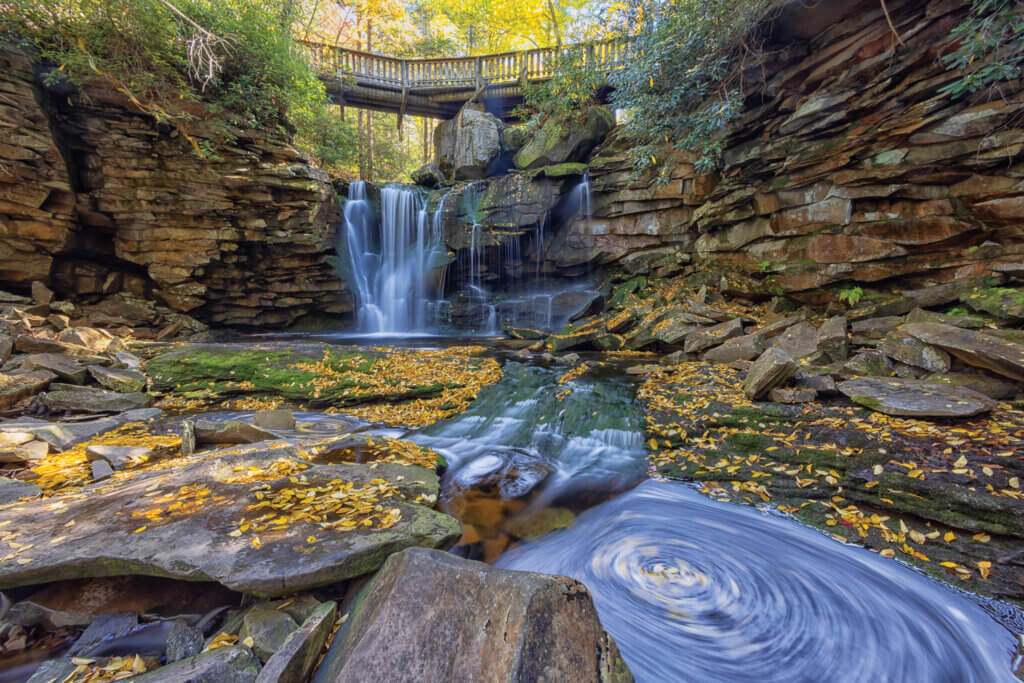
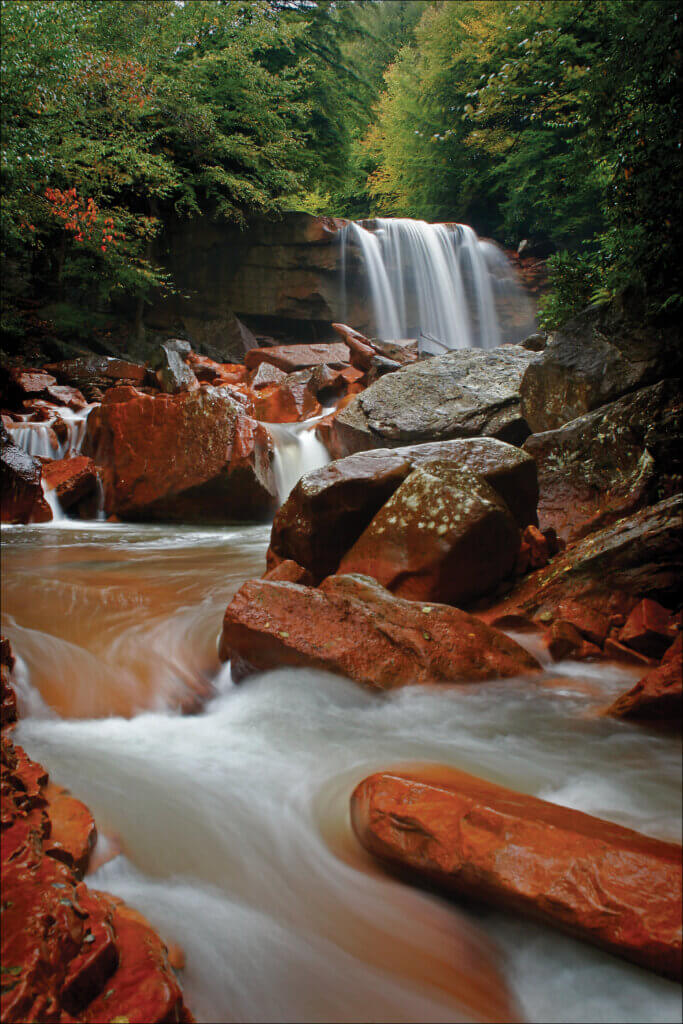
Other Falls to Fall For
Blackwater Falls is renowned across the Mountain State. It’s easily one of West Virginia’s most recognizable natural features, with its tannin-colored waters and 57-foot drop. However well-recognized, this roaring beauty isn’t the only waterfall tucked away in the lush state park it calls home.
Elakala Falls, made up of four unique waterfalls, pours similarly colored waters to that of Blackwater Falls—the tannins of fallen hemlock and red spruce needles are released within the water, giving it its distinctive hue. To see these falls for yourself, travel along the Elakala Trail near Blackwater Lodge. This 0.5-mile trail gives you a view you won’t want to miss.
Recently, the Blackwater Falls State Park boundary expanded to include Douglas Falls, adding it to the park’s many attractions. Located on the North Fork Blackwater River, this 35-foot waterfall descends upon a rocky bed stained a vibrant orange color located upstream. Several smaller falls, such as Kennedy Falls, Albert Falls, and Teresa Falls, can be found along this same portion of the river.
Visit wvtourism.com/west-virginia-waterfall-trail to find where the waterfalls flow all across the Mountain State!
If you’re looking for adventure in the winter months, Blackwater Falls has you covered. In addition to 10 miles of cross country ski trails spread throughout the park and surrounding area, the park recently installed what Paul A. Redford, deputy chief of the State Parks system, calls “one of the premier sled runs in the Eastern United States.” The sled run operates mid-December through February and is a popular destination for winter recreation. Some kids—not to mention parents and grandparents—will sail down and get toted back up that hill on the Magic Carpet conveyor belt as long as time allows.
In addition to the Smokehouse at Blackwater Falls restaurant in the lodge, Blackwater Falls has a snack shop with homemade pepperoni rolls. Located in the park’s gift shop—Blackwater Trading Co., described by Redford as “one of the largest gift shops in the state park system”—the snack shop keeps guests energized on the trails and off, and features just about “everything West Virginia,” including Mountain State foods, beers, and wines.
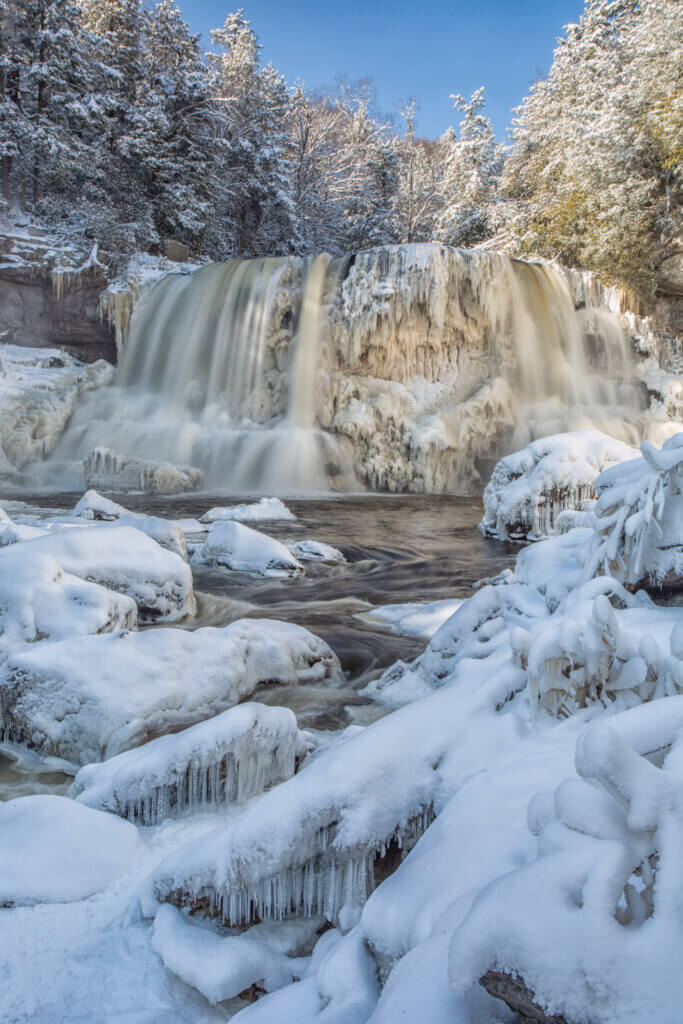
While the falls are the star, we would be as cut off from them as folks were in the 1850s if not for the staff. Redford lists just a few of their responsibilities, including building new shelters, maintaining the property, and interacting with guests. In the winter months, their daily chores expand to plowing snow, clearing boardwalks, and maintaining trails. None of our state parks could exist without these dedicated staff who show up even on the snowiest and iciest days of the year.
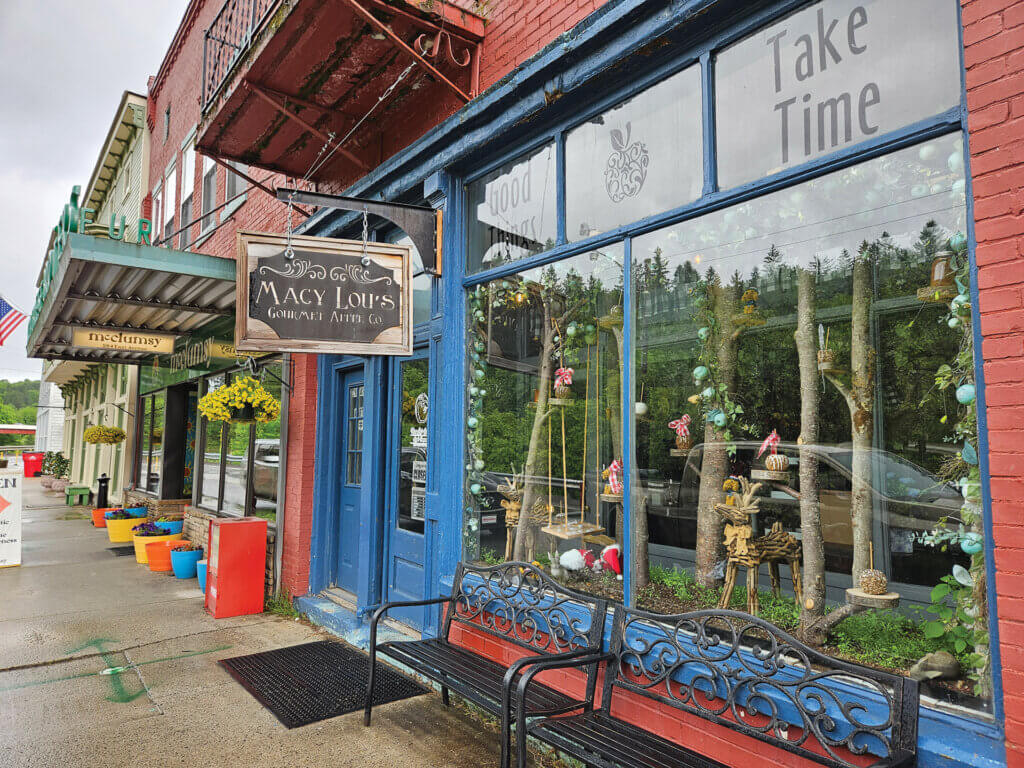
Out on the Town
Mere minutes outside of Blackwater Falls State Park’s boundaries are the sister towns of Thomas and Davis. Both towns abut stretches of the Blackwater River, which forms Blackwater Falls. These small Allegheny Mountain towns are rife with culture, intrigue, and adventure, making them great day excursions from your state park home base. Find antique shops, art galleries and studios, live music, and endless opportunities for outdoor recreation and exploration.
Redford says this park is somewhat different from others because it receives a steady stream of traffic year ’round, with its spring wildflowers, cool summers, vibrant leaf displays in fall, and nearby ski opportunities in winter. For anyone who’s been there in winter, you know it can get mighty cold and snow harder than you can see. As a result, the main boardwalk to the falls has to be closed some icy days, which makes for even a bigger treat when it’s just snowy enough for a nice photo, but not heavy enough to prevent you from getting there. There’s also the classically surreal beauty of the falls completely frozen over.
If you’ve never been to Blackwater Falls or haven’t been in a while, there’s no better time than the present. It remains one of the “most pleasing natural objects” you’ll ever behold, in West Virginia or anywhere in the world.
Marshall Markley, Blackwater Falls State Park superintendent, passed away at the time of writing this article in April 2024. His love of West Virginia and the State Parks system will be greatly missed.

